Exhibition: In Sparkling Company: Glass and the Costs of Social Life in Britain During the 1700s, Corning Museum of Glass, Corning, New York, May 22, 2021 – January 2, 2022.
In Sparkling Company, a ground-breaking exhibition curated by Christopher Maxwell at the Corning Museum of Glass, invites us into the wondrous world of glass in Britain in the long eighteenth century (Fig. 1). Gleaming, glittering, and reflecting surfaces shore up the extraordinary versatility of a commodity that emerged from the confluence of art and science and the intersections between commerce and luxury. But there is more to glass than meets the eye. For that arbiter of English taste, the Earl of Shaftesbury, the “looking-glass” or “pocket-mirror” evoked self-reflection, as it did for the Scottish philosopher and economist Adam Smith, who mused, “We suppose ourselves the spectators of our own behaviour, and endeavour to imagine what effect it would, in this light, produce upon us. This is the only looking-glass by which we can, in some measure, with the eyes of other people, scrutinize the propriety of our own conduct.”[1] What “conduct,” then, is laid bare by the objects displayed in the exhibition at Corning? What questions of home and empire do they raise?
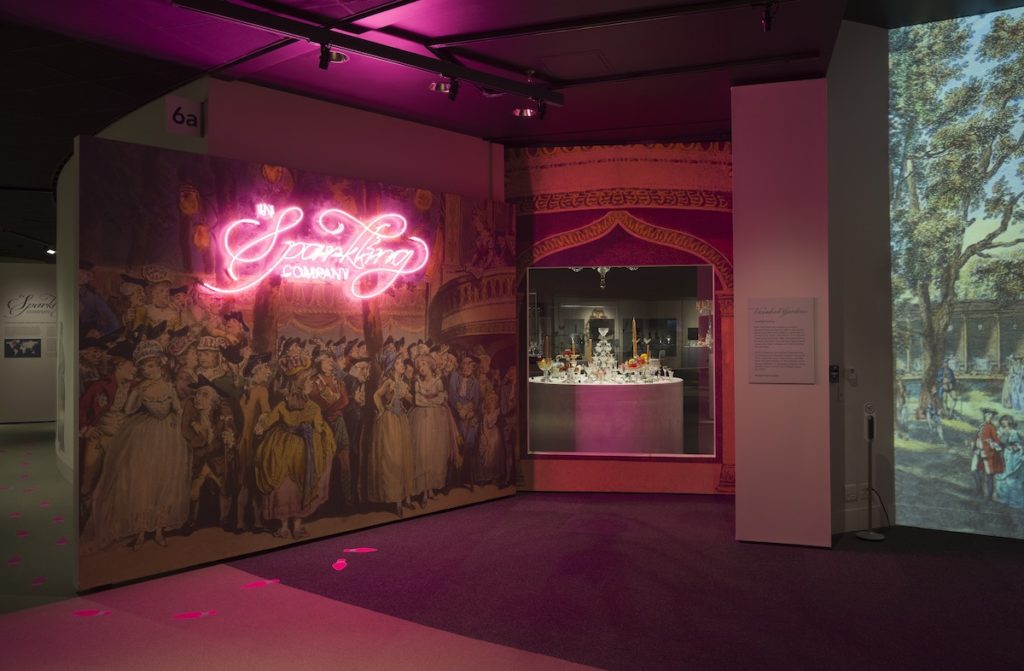
Glass mediates the thresholds of aesthetics, discovery, adventure, and quotidian pleasures. Its ability to change color, reflect light, create illusions, contain things, create protective barriers, and draw the far into the near reveals the fundamental human desire to intervene in the world—to understand, shape, and participate in its material and corporeal flows. According to Maxwell, glass became a “metaphor for British modernity” in the eighteenth century, when its polish, smoothness, and clarity came to represent the “prevailing cultural ideals of politeness” that were believed to characterize the modern British consumer.[2] In the nineteenth century, glass would once again draw attention to British modernity at the Crystal Palace, home to the Great Exhibition of 1851 in London.
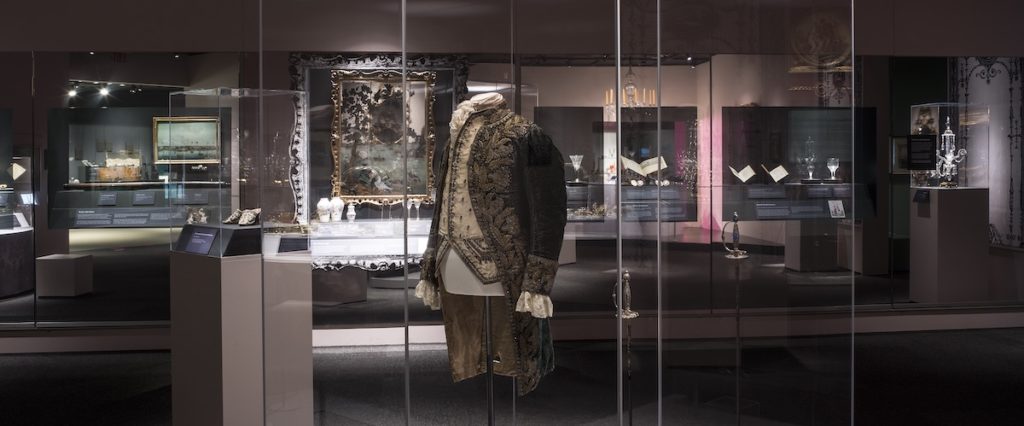
Organized from the Corning Museum’s acclaimed glass collections, as well as from private collections and other museums, In Sparkling Company gives us some dazzling evidence of glass artistry and technical virtuosity. A panoply of snuff boxes, glass bottles, crystal dishes, optical instruments, gilded mirrors, buckles, beads, glasses and goblets, screens, and glass panels greets the visitor in a small yet surprisingly spacious gallery (Fig. 2). Surrounded by their gleam and glitter, we are drawn to their luster, not just because of their visual appeal or the unique visual experiences they create, but also because they draw our attention to the human body: to its tastes and preferences, performative potential, propensity for public spectacle, deeply personal engagements, involvement with imperial goods, and investments in science and art. No matter where we look, glass, the exhibition reminds us, has permeated every facet of human life.
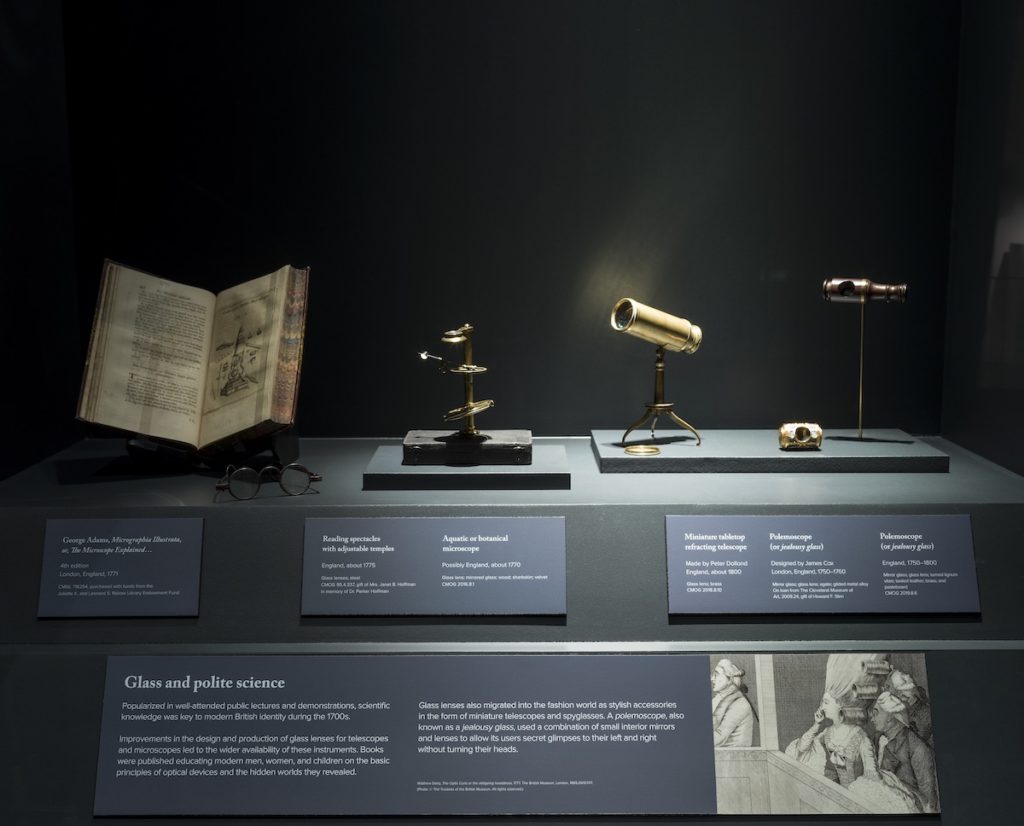
The English diarist Samuel Johnson once observed that glass was responsible for “a great part of the happiness of the world,” while the glass-maker “facilitate[ed] and prolong[ed] the enjoyment of light, enlarging the avenues of science, and conferring the highest and most lasting pleasures; he was enabling the student to contemplate nature, and the beauty to behold herself.”[3] Johnson may very well have addressed one of the most intriguing objects in the exhibition, a polemoscope, otherwise known as a “jealousy glass,” a small, portable object made by the acclaimed jeweler and watchmaker James Cox. Relying on a “combination of small interior mirrors and lenses,” this ingenious device enabled one to discreetly see what was happening to one’s left or right. Quite simply, it indulged the delights of spying.[4] Extending the reach of scientific scrutiny into the more public sphere of sociability, ocular instruments like these proliferated throughout the eighteenth century, facilitating the art of close looking and drawing the secluded intimacy of surfaces and textures into view. A pair of spectacles, a botanical microscope, a miniature telescope, and an illustrated treatise on microscopes grouped together in the exhibition hone in on some of the new technologies that ushered in new ways of looking and new visual realities (Fig. 3). Indeed, the very acts of seeing—and of being seen—thread their way throughout the exhibition, starting with a leisurely walk in an imaginary Vauxhall, eighteenth-century London’s pleasure gardens, where looking was fashioned into a complex art (Fig. 1). It is here that Sir Samuel Morland once filled a room with mirrors, and thousands of glass lamps illuminated the walkways, allowing the elite as well as commoners to encounter what Danielle Thom describes as “their very best, and very worst, selves.”[5]
A trail of pink footsteps—a playful nod at the gardens’ enticing allure—takes visitors past life-size portraits lifted from Thomas Rowlandson’s well-known watercolor drawing of Vauxhall. It brings us to the entrance of the exhibition, where we leave behind London’s sensory delights and widen our gaze to encompass Britain’s growing empire. Here, in sharp contrast to the ostentation of Vauxhall, we encounter a quiet display of drinking vessels that launch the locally grounded yet globally-oriented story of British glass borne out by the colonial materials, technologies, and bodies entangled with their very production. For instance, lead glass incorporated saltpeter, an alkaline mineral that was mined in Bengal, where the East India Company was headquartered (Job Charnock, founder of Calcutta, was responsible for procuring saltpeter in Bengal for the Company).[6] While reading the exhibition wall text, I was struck by the observation that lead crystal “sparkled in candlelight and could be engraved, or facet-cut like a diamond”—the comparison with precious gems bringing to mind the glittering diamonds that built the fortunes of high-ranking Company administrators.
The choice to begin the exhibition with such explicit references to Britain’s empire unabashedly acknowledges the political economies and cultural legacies of colonial exploitation with which the exhibition artifacts are bound up. Take, for instance, the looking glass in which Jane Martha Temple, Countess of Portland, once beheld her powdered and rouged reflections. Staring into it, we are invited to think about the careful constructions of whiteness that European elites took pains to maintain, their curated appearances bolstering their (self) perceived notions of cultural superiority. Nearby, a small ruby-red glass snuff-box pivots away to the more intimate, olfactory world of snuff, that popular eighteenth-century product made out of tobacco, a plant commodity so profitable it prompted British colonists and enslavers to establish plantations in Maryland, Virginia, and North Carolina. Nearly obscured by the red gleam of the glass cover, the prized contents are revealed only after the fashionable box is flipped open by an expert hand.[7] Like so many other eighteenth-century commodities, glass is inseparable from the patterning of human mannerisms—and indeed of human lives—shaped by products ushered into British households by a growing empire.
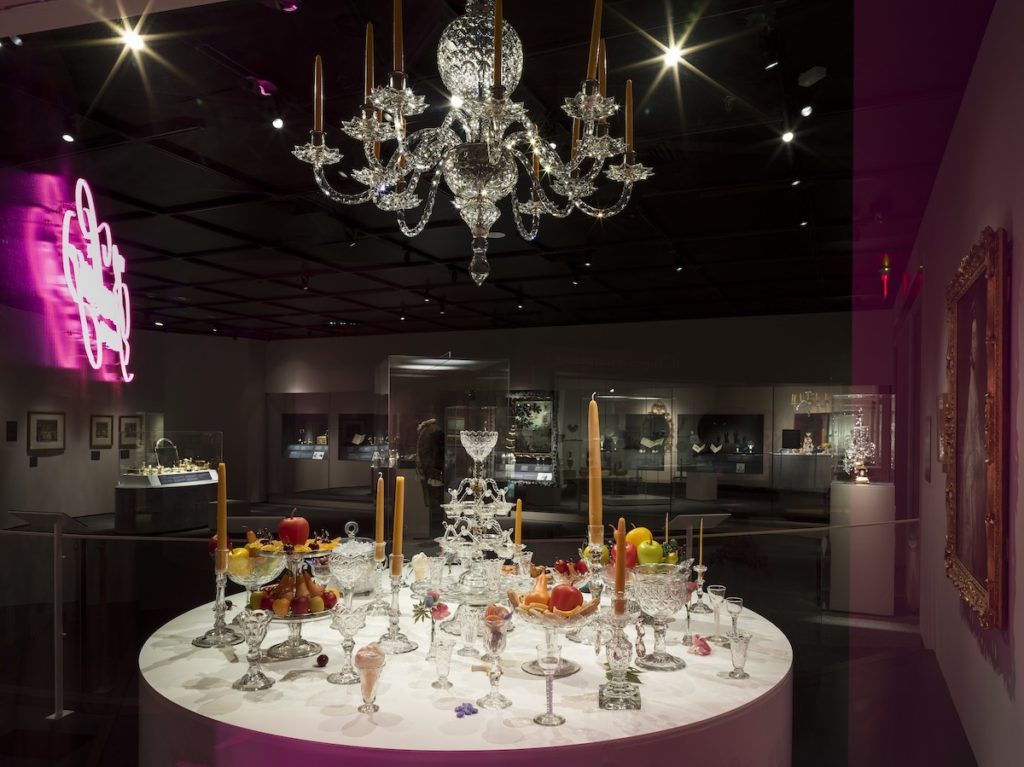
But the most spectacular confrontation with colonial legacies of glass takes place at a dessert table laden with cut-glass tableware designed for sugary confections and beverages (Fig. 4). Drawing our attention to sugar, the plant commodity whose sweetness fueled the evolution of a national addiction and built enormous wealth on the backs of enslaved African labor, the installation accentuates both the sensory pleasures of eating and drinking as well as the logics of design that accommodated an array of culinary delights concocted for the British palate. Here, too, Maxwell surprises us by slipping in objects made by contemporary glass-blowers whose workmanship—to which he has unique links at Corning—brilliantly animates the display: glass cherries tumble out of a bowl and onto the table, their shiny gloss evoking the glistening surfaces of candied fruit that would have once filled the cut-glass containers. It is with these creative touches that Maxwell pushes the envelope. Not content with simply displaying beautifully crafted tableware, he urges us to look beyond their artistry, glitter, and gleam to remember the laboring bodies and hands enmeshed with their contents. As he would explain to me later in an email exchange, as the exhibition idea evolved, “the connection between so many of the museum’s glass vessels and British sugar production in the West Indies began to reveal themselves in the collection.”[8]
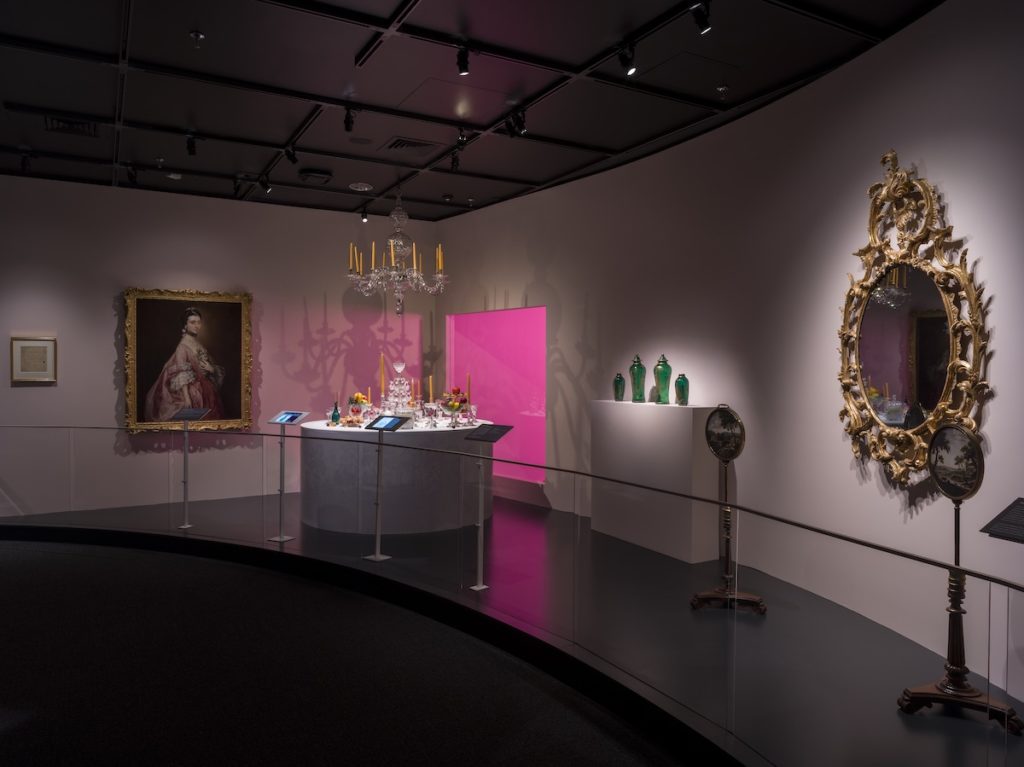
An interactive digital display brings to life these material and cultural histories, while objects that we would not necessarily associate with those histories surprise us with their juxtapositions and their direct and indirect connections to enslaved labor. Enter Thomas Gainsborough’s portrait of Mary Little, the wife of a wealthy textile merchant, hanging near the dessert table—a striking reminder of the privileged elite who would have owned items like the glittering utensils on view (Fig. 5). Dressed in shimmering rose pink silk, with a glass aigrette sparkling in her well-coiffed hair, she presents a sharp contrast to Geney, a sixteen-year-old slave girl sold in Connecticut, who is the main subject of a bill of sale displayed alongside. Unlike Mary Little, she remains invisible, her absent figure a visual silencing at a time when glamor and visibility were considered the purview of the rich, white, and powerful. A conspicuous sign of how colonial wealth could produce two starkly contrasting paradigms of womanhood—one free (and visible) and the other enslaved (and invisible)—the pairing of the two women from vastly different backgrounds highlights the global reach of the British empire and the racial inequalities it forged, fostered, and relied upon.
The best exhibitions delight, surprise, and give us pause. Seeing Mary Little’s portrait, a picture I had encountered countless times at the Yale Center for British Art where it resides, in an exhibition of eighteenth-century British material culture made perfect sense. What I had not expected, however, was to see the painting in the context of colonial wealth production so vividly shored up by glass, a commodity so popular, so widespread that its sparkling visibility in the everyday lives of Britons easily blurred its intimate connections to colonial geographies and resources. In teasing apart these overlaps and intersections, In Sparkling Company coaxes us to see the portrait of Mary Little as something more than a picture painted by one of Britain’s acclaimed portrait painters—as tangible evidence of the economic, political, and social networks of empire that facilitated the ebb and flow of life in Britain and the colonies, where they shaped new aesthetic preferences and material intimacies. Glimpses of these networks can be found throughout the exhibition: in the ornamental green vases decorated with gilded figures whose Chinese-inspired designs hark back to porcelain vessels that arrived on Company ships from China; the wine or cordial glasses ornamented with Chinese-style landscapes; the tea caddy with glass canisters; the Chevron patterned beads that British traders used in West Africa to buy gold, ivory, and enslaved humans; or the commemorative goblet celebrating the launch of the slave ship King George, named after George III. Glass emerges as the bearer of complex narratives of national and colonial identity, its materiality cycling in and out of lives lived in Britain and in different corners of a growing empire, all the while making visible innovative design ideas.
What then do we make of the ability of glass to fool the eye? Artful illusions were part and parcel of fashioning desirable bodies. Flower patterns created through tiny sparkling beads for a pair of women’s shoes resembled ornate brocade designs, and jewel-like glass embellishments—from buttons to buckles—sewn into men’s clothing and accessories transformed masculine bodies into glittering ornaments (Fig. 2). British plate glass was brighter and smoother than ever before, intensifying sunlight by day and the flickering glow of candlelight by night. There was also the influx of objects, prized materials, and design ideas from China whose impact on British craftsmanship can be seen in the glass objects made to resemble Chinese porcelain or in the wine glasses decorated with Chinese style landscapes. Reverse-painted looking glasses produced by Chinese artists on British manufactured glass for British clients reveal the unique confluence of art, design, and manufacture that emerged from the China trade. Imitating, mimicking, appropriating, and fusing design concepts became the norm, shaping the craze for chinoiserie, the popular design movement inspired by Chinese art and objects. Glass wove its way in and out of all these creative impulses and design innovations as the principal surface upon which the desires and tastes of the British elite were imprinted.
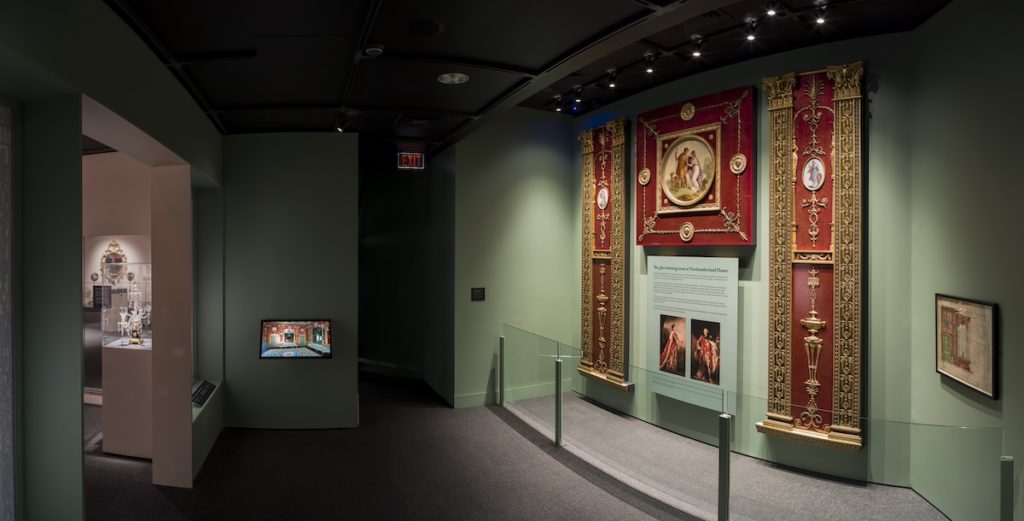
The reconstructed red glass panels from the drawing room at Northumberland House, where the Duke and Duchess of Northumberland hosted lavish parties, are one of the main attractions of the exhibition (Fig. 6). In an era when candlelight softened the glow of skin and brightened the luster of jewels, artifacts like candelabra, chandeliers, girandoles, and mirrors created highly sensual encounters. Copper flakes sprinkled on the reverse of the panels twinkle through crimson tones, giving the impression of gold dust scattered across red silk. Interspersed with drawings of designs by the acclaimed architect Robert Adam, who also designed the panels, these fragments, restored for the exhibition through a collaboration with The Victoria and Albert Museum in London, manage to convey the splendor of an era long lost (Northumberland House was demolished in 1874). A tour-de-force of design and technical virtuosity, they offer a glimpse of the unique visualities enhanced and transformed by glass. Bejeweled figures seen against their crimson backdrop would have sparkled and glittered a bit more—the very same individuals might have stepped into the shoes or donned the coat displayed across the alcove from where the panels are displayed, sat at the Countess of Portland’s looking glass, or awoken from their slumber for the elaborate grooming ceremonies known as the morning “toilette,” satirized so mercilessly in the prints after William Hogarth seen on the opposite wall.
Maxwell’s thoughtful recreation of the world of appearances constructed through and with glass permeates the main gallery, while artifacts of science and commerce pack the outer edges. Spatially, Britain’s global connectivity becomes visible through clothing, shoes, swords, buckles, glassware, and tableware. How did these artifacts participate in the social and cultural lives of their human consumers? How did they produce history? Digital technologies animate these questions for us, while virtual reality brings back to life the visual effects of glass at different times of day, as in the reconstructed Northumberland House glass panels. At a more fundamental level, the exhibition wall text, written in close consultation with Cheyney McKnight of “Not Your Momma’s History,” ensures that the history of slavery is never overlooked or ignored, but is in fact embedded in the story of eighteenth-century British glass that unfolds around us.
As artful as the exhibition design (and indeed, integral to it) is the lighting deployed throughout the gallery—just enough to evoke a candlelit atmosphere, with some displays spotlit to draw our attention to individual objects. Particularly striking is the muted lighting in the alcove dedicated to the ornamental panels from Northumberland House, whose gentle glow draws out the sparkle of glass, bringing home the sensory experience of a sumptuous eighteenth-century drawing room. Glass intervenes in the act of viewing everywhere in the exhibition: mirrored walls reflect images of exhibition visitors back to them, prompting participation, however inadvertently, in the wondrous effects of glass; an exhibition entrance bathed in pink neon light evokes the glass signage of entertainment venues of early twentieth-century Paris or contemporary Las Vegas; and a hanging chandelier casts intricate shadows across the wall. But what makes the exhibition truly unique is the soundscape by Undertone Music. Featuring the banjo, flute, oboe, and clarinet, the composition conjures up the sounds of the eighteenth-century worlds of the elite and the enslaved that the glass artifacts would have inhabited. (A more subtle hint of birdsong animates the walk past Vauxhall.)
In Sparkling Company is accompanied by a richly illustrated catalogue that is sure to become an invaluable contribution to the study of art history and material culture. With its examination of such topics as “slavery and glass,” the “glass of fashion,” and the “British scientific glass Enlightenment,” this compilation of scholarly essays titled, In Sparkling Company: Reflections on Glass in the 18th-Century British World, resonates with the exhibition’s main themes, while delving deeper into a commodity that played such a key role in shaping taste and sociability in Britain and across the British empire. Remarkably, in the midst of a global pandemic, Maxwell managed to organize a two-day seminar to examine the broader European histories of glass within the contexts of eighteenth-century domesticity and its connections to the transatlantic world. Interspersed with these discussions were glass blowing demonstrations, including a hot glass live stream with Eric Goldschmidt, a contemporary glassmaker and the museum’s glass programs supervisor. Striking a perfect balance between an exhibition curated for the general public and a series of thoughtful academic and material engagements, In Sparkling Company gives every visitor the chance to interact with the complex histories of British glass on one’s own terms. Above all, the exhibition’s prismatic approach to knowing through looking and making draws glass back into the center of our world. It urges us to re-consider the material and human costs that brought glass’s modernity into being, and the extent to which the collective histories of those costs remain entangled with the glassware we use in our own lives today.
Romita Ray is Associate Professor of Art History at Syracuse University and works on the art and architecture of the British Empire in India
Acknowledgments: The author thanks Christopher (Kit) Maxwell, curator of In Sparkling Company, for his generous insights, and Suzanne Abrams Rebillard at the Corning Museum of Glass for her help with the installation photographs.
[1] The Earl of Shaftesbury quoted in John Uhr, Performing Political Theory: Pedagogy in Modern Political Theory (Singapore: Palgrave Macmillan, 2018), 42; Adam Smith, The Theory of Moral Sentiments; or, an Essay Towards an Analysis of the Principles by which Men Naturally Judge Concerning the Conduct and Character, First of their Neighbours, and Then of Themselves (London: Printed for Cadell and Davies, 1812), 192.
[2] Christopher Maxwell, “In Sparkling Company: Presenting Eighteenth-Century Britain in Western New York,” British Art Studies 21 (November 2021), http://britishartstudies.ac.uk/issues/issue-index/issue-21 (accessed February 15, 2022).
[3] Samuel Johnson, The Rambler 9 (April 17, 1750), 15-16.
[4] Exhibition label, “Glass and Polite Science,” In Sparkling Company; Marvin Bolt, “The British Scientific Glass Enlightenment During the Long 18th Century,” in In Sparkling Company: Reflections on Glass in the 18th-Century British World, ed. Christopher L. Maxwell (Corning, New York: The Corning Museum of Glass, 2020),142.
[5] Danielle Thom, “Welcome to Vauxhall Pleasure Gardens,” Museum of London, October 24, 2017, https://www.museumoflondon.org.uk/discover/vauxhall-pleasure-gardens (accessed February 15, 2022).
[6] P. Thankappan Nair, Job Charnock: The Founder of Calcutta (In Facts and Fiction); An Anthology (Calcutta: Calcutta Old Book Stall, 1977), 8, 144.
[7] For more about snuffboxes, see Clare Le Corbeiller, European and American Snuff Boxes 1730-1830 (New York: Viking Press, 1966); and Vanessa Alayrac-Fielding, “From Oroonoko Tobacco to Blackamoor Snuffboxes: Race, Gender and the Consumption of Stuff in Eighteenth-Century Britain,” Humanities 10, 3 (2021), 1-18.
[8] Christopher Maxwell, email message to author, February 4, 2022.
Cite this note as: Romita Ray, “In Sparkling Company: A Review,” Journal18 (March 2022), https://www.journal18.org/6185.
License: CC BY-NC
Journal18 is published under a Creative Commons CC BY-NC International 4.0 license. Use of any content published in Journal18 must be for non-commercial purposes and appropriate credit must be given to the author of the content. Details for appropriate citation appear above.
